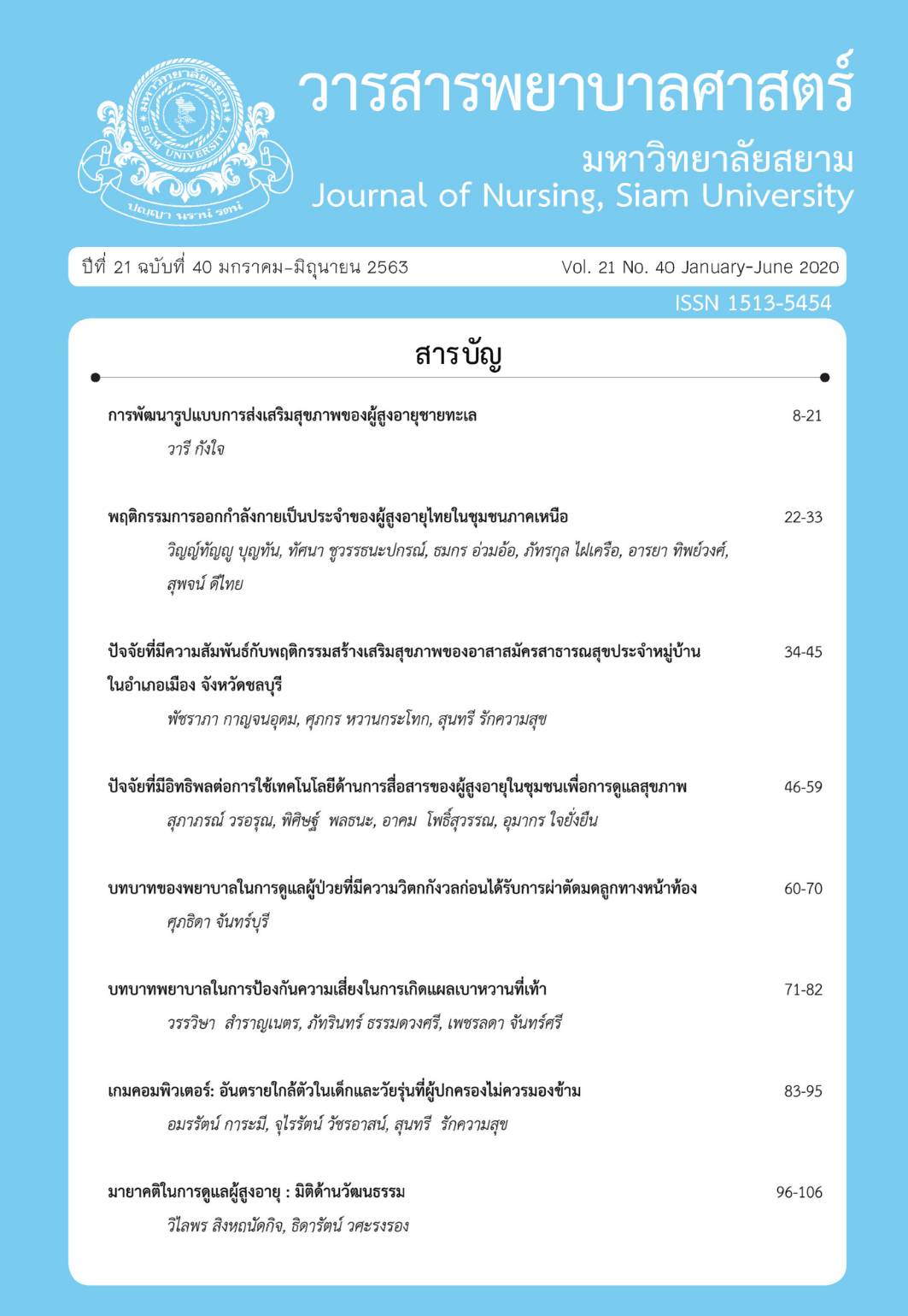Factors Influencing the Use of Communication Technology of Older People in Community for Health Care
DOI:
https://doi.org/10.14456/jnsu.v21i40.242889Keywords:
older people, elderly, communication technology, health careAbstract
This study aimed to investigate the predictive factors influencing the use of communication technology in older people. The dependent variables were perceived benefits of using communication technology, perceived ease of using communication technology, attitudes about using communication technologies and intention to use communication technology among the elderly. A total of 338 elderly subjects participated in the study, and the instrumentation were questionnaires that was developed by using the Technology Acceptance Model (TAM). The reliability of this questionnaire was in high level (r = .85). A descriptive statistics and hierarchical regression analysis was used to analyze the data.
According to the findings, most elderly people used various kinds of communication technology to facilitate improved healthcare behaviors. Older people believed that perceived ease of using communication technology (Beta=.856, p<.001), and intention to use communication technology among the elderly (Beta=.615, p<.001), which can facilitate older people in improving their health behaviors.
In conclusions, the research results show the perceive benefits and the perceived ease of using communication technology can predict an intention to use communication technology in elderly healthcare. The Implication in this research will assist health care team to apply a communication technology to improve healthcare in appropriate situation such as training knowledge via mobile device or another communication media.
References
คณะกรรมการผู้สูงอายุแห่งชาติ. (2552). แผนผู้สูงอายุแห่งชาติ ฉบับที่ 2 (พ.ศ. 2545-2564) ฉบับปรับปรุงครั้งที่ 1 พ.ศ. 2552. กระทรวงพัฒนาสังคมและมนุษย์.
จารุวรรณ พิมพิค้อ และสมาน ลอยฟ้า. (2552). การใช้และความต้องการใช้เทคโนโลยีสารสนเทศและการสื่อสารของผู้สูงอายุในเขตเทศบาลนครขอนแก่น. คณะมนุษยศาสตร์และสังคมศาสตร์ มหาวิทยาลัยขอนแก่น, ขอนแก่น.
จันทนา ทองประยูร. (2552). สื่ออินเทอร์เน็ตกับการพัฒนาคุณภาพชีวิตของผู้สูงวัย. เอกสารประกอบการประชุมวิชาการเรื่อง“แนวทางสู่ การเข้าถึงผู้สูงวัยที่ยังเข้าไม่ถึงคอมพิวเตอร์และอินเทอร์เน็ต”. ชมรมเทคโนโลยีสารสนเทศและการสื่อสารเพื่อความเท่าเทียมกัน, กรุงเทพฯ.
เฉลิมศักดิ์ บุญประเสริฐ. (2560). ปัจจัยที่มีอิทธิพลต่อการยอมรับการใช้แอปพลิเคชั่นไลน์ของสูงอายุ. วิทยานิพนธ์หลักสูตรบริหารธุรกจิมหาบัณฑิต สาขาวิชาการบริหารธุรกจิ บัณฑิตวิทยาลัย มหาวิทยาลัยราชภัฏเชียงใหม่
ธีระ กุลสวัสดิ์, สมคิด เพชรประเสริฐ, เอกวิทย์ มณีธร. (2557). แบบจำลองพฤติกรรมการมีส่วนร่วมทางการเมืองในการเลือกตั้งของนักศึกษาในสถาบันอุดมศึกษาในประเทศไทย. ภาควิชารัฐประศาสนศาสตร์ คณะรัฐศาสตร์และนิติศาสตร์ มหาวิทยาลัยบูรพา. วารสารการเมืองการบริหารและกฎหมาย, ปีที่ 6(3);77-98.
พรเพ็ญ จันทรา, วัชรวลี ตั้งคุปตานนท์. (2555). ปัจจัยที่สร้างการยอมรับภายใต้สังคมพหุวัฒนธรรมในการใช้งานเว็บไซต์ของผู้สูงอายุ. วิทยานิพนธ์วิศวกรรมศาสตร์ สาขาวิชาการจัดการเทคโนโลยีสารสนเทศมหาวิทยาลัยสงขลานครินทร์, สงขลา.
ภัทริกา วงศ์อนันต์นนท์และสรานันทน์ อนุชน. (2561). เทคโนโลยีสารสนเทศต่อสังคมผู้สูงอายุ Information Technology for Aging Society. วารสาร
ทหารบก. ปีที่ 19 (3); 27-32.
รุจิภา สินสมบูรณ์ทองและสุวพัชร วุฒิเสน. (2561). พฤติกรรมและการรับรู้การใช้เทคโนโลยีสารสนเทศที่ส่งผลต่อการส่งเสริมสุขภาพ ของผู้สูงอายุในกรุงเทพมหานคร. การประชุมวิชาการระดับชาติ วิทยาลัยนครราชสีมา ครั้งที่ 5 ประจำปี2561 (5th NMCCON 2018).
สำนักงานสาธารณสุขจังหวัดสุพรรณบุรี. (2562). สถิติประชากรผู้สูงอายุ จังหวัดสุพรรณบุรี ปี พ.ศ. 2556 - พ.ศ.2562. สถิติประชากร จังหวัดสุพรรณบุรี.
Cronbach, L.J. (1990). Essentials of psychological testing. (5th ed.). NewYork: Harper & Row. pp. 202-204.
Davis, F. D. (1989). "Perceived usefulness, perceived ease of use, and user acceptance of information technology". MIS Quarterly, 13(3): 319–340.
Gajos K.Z., Muller M., Grosz B.J. (2015). Acceptance of Mobile Technology by Older Adults: A Preliminary Study.
Kiseal Y and Folly L. (2008). Age cohort analysis in adoption of mobile data services: genXers versus
baby boomers”. Journal of Consumer Marketing, 25;5.
Krejcie, R. V. & Morgan, D. W. (1970). Determining Sample Size for Research Activities. Educational and Psychological Measurement, 30(3), pp. 607-610.
Luarn, P. and Lin, H.H. (2005). Toward an Understanding of the Behavioral Intention to Use Mobile Banking. Computers in Human Behavior, 21(6), 873-891.
Pan, S & M. Jordan-Marsh. (2010). Internet use intention and adoption among Chinese older adults: From the expanded technology acceptance model perspective. Computers in Human Behavior, 26(5), 1111-1119.
Polit, D. F., & Hungler, B. P. (1999). Nursing research: Principles and methods (6th ed.). Philadelphia: J.B. Lippincott.
Sebastiaan T.M.Peek, E.J.M.Wouters, J.H. (2014). Factors influencing acceptance of technology for aging in place: A systematic Review. International Journal of Medical Informatics, 83(4), 235-248.
Venkatesh, M. Morris, and G. B. Davis. (2003). “User acceptance of information technology: Toward unified view,” MIS Quarterly, vol. 27, no. 3, pp. 425-478.
World Health Organization. (2020). COVID-19 – WHO Thailand Situation Reports. Situation reports. World Health Organization.
World Health Organization. (2020). Ageing and health; A rapidly changing world. Situation reports. World Health Organization.
.
Downloads
Published
How to Cite
Issue
Section
License
Content and information published in the Journal of Nursing, Siam University is the comment and responsibility of the authors.
Articles, information, images, etc. published in the Journal of Nursing. Siam University is the copyright of the Journal of Nursing, Siam University. If any person or entity wants to take all or part of it for publication for any purposes, please reference the Journal of Nursing, Siam University.



